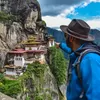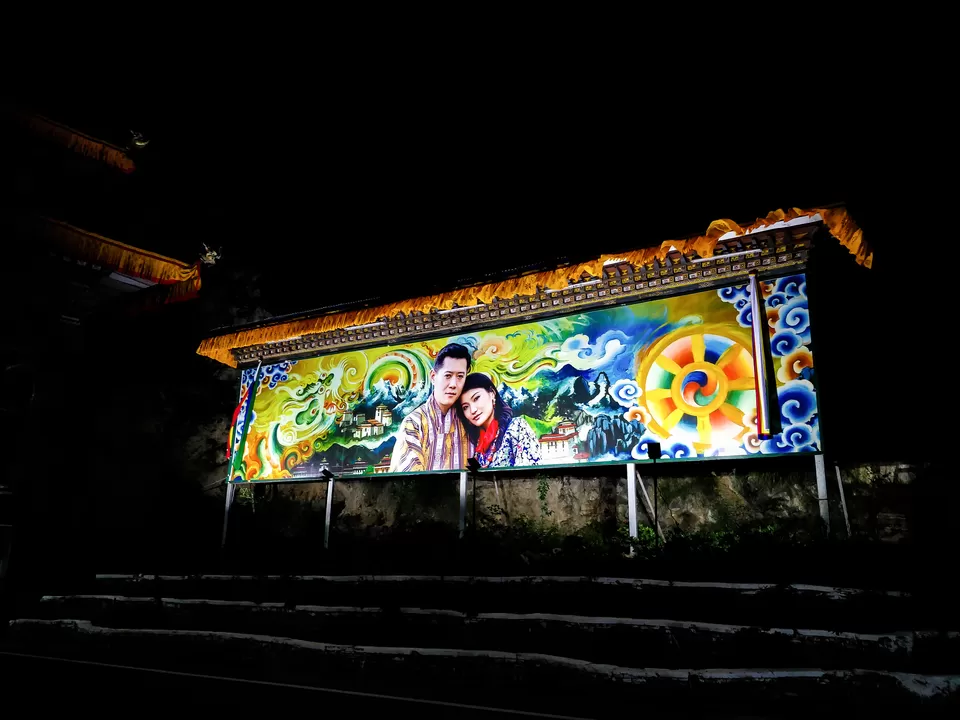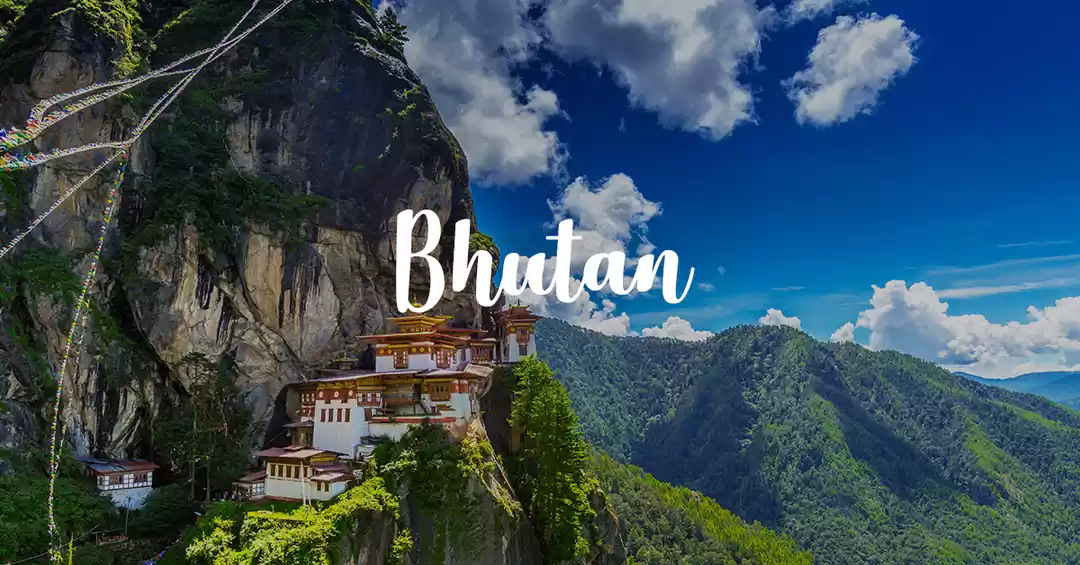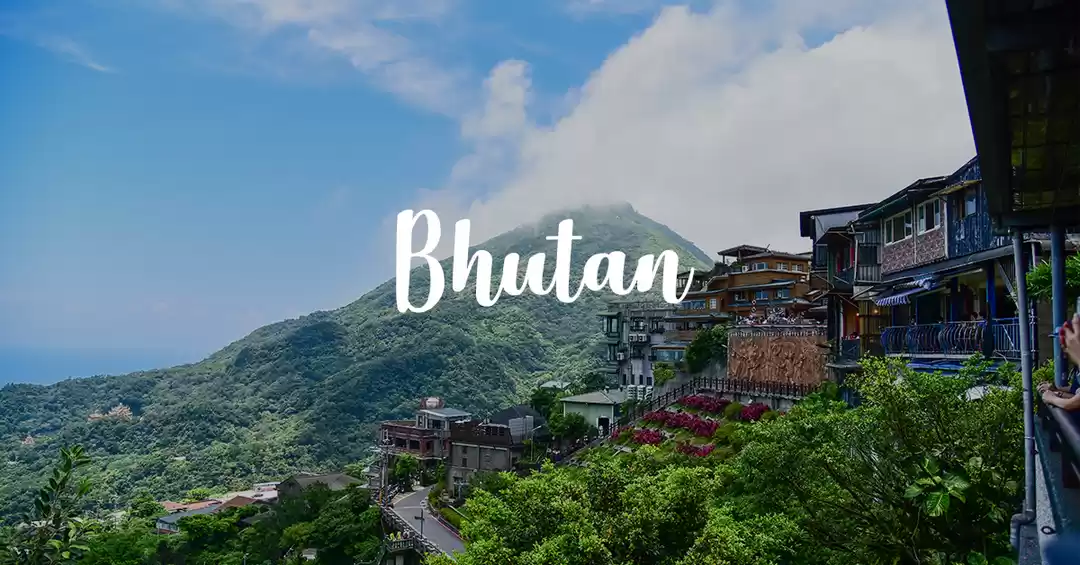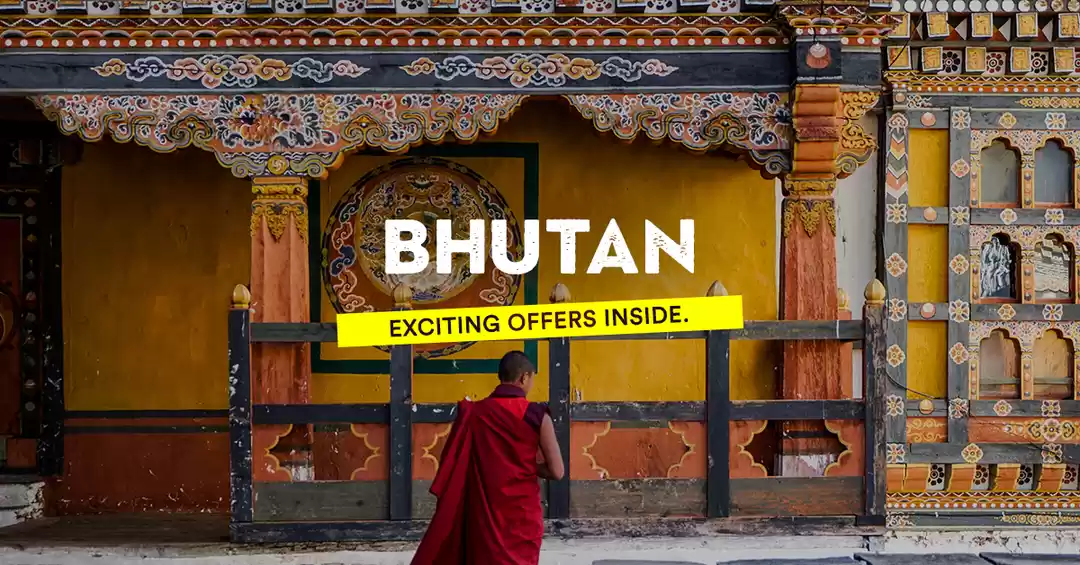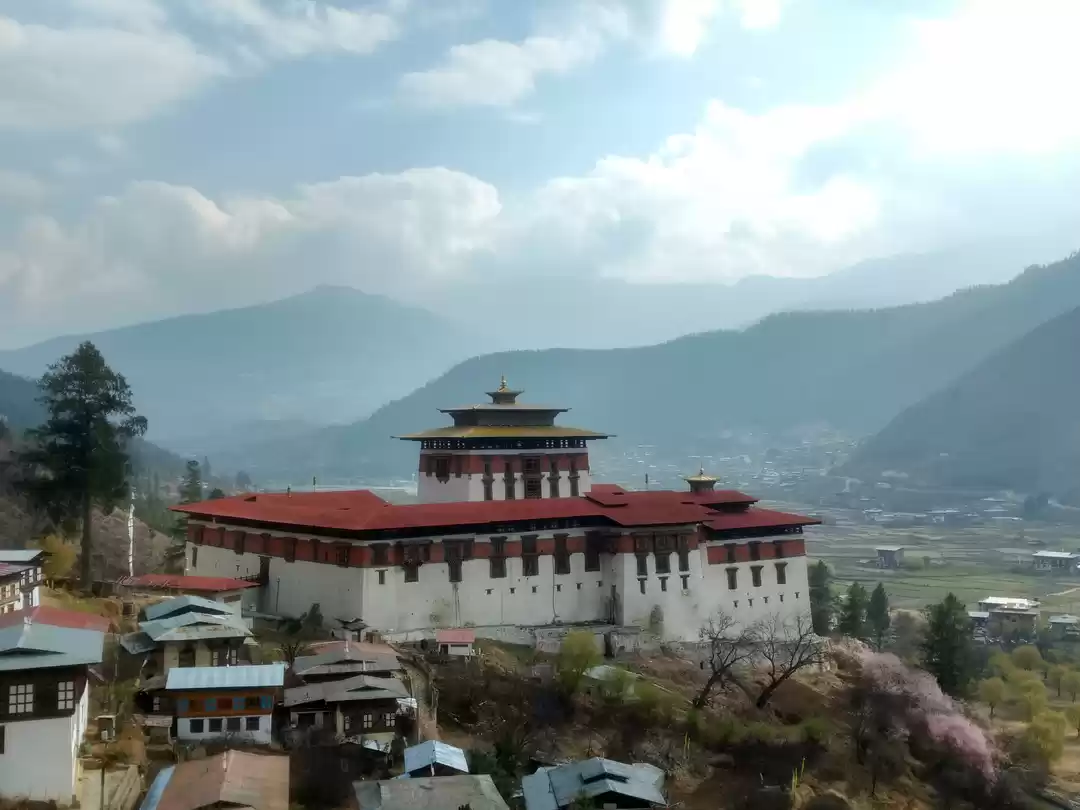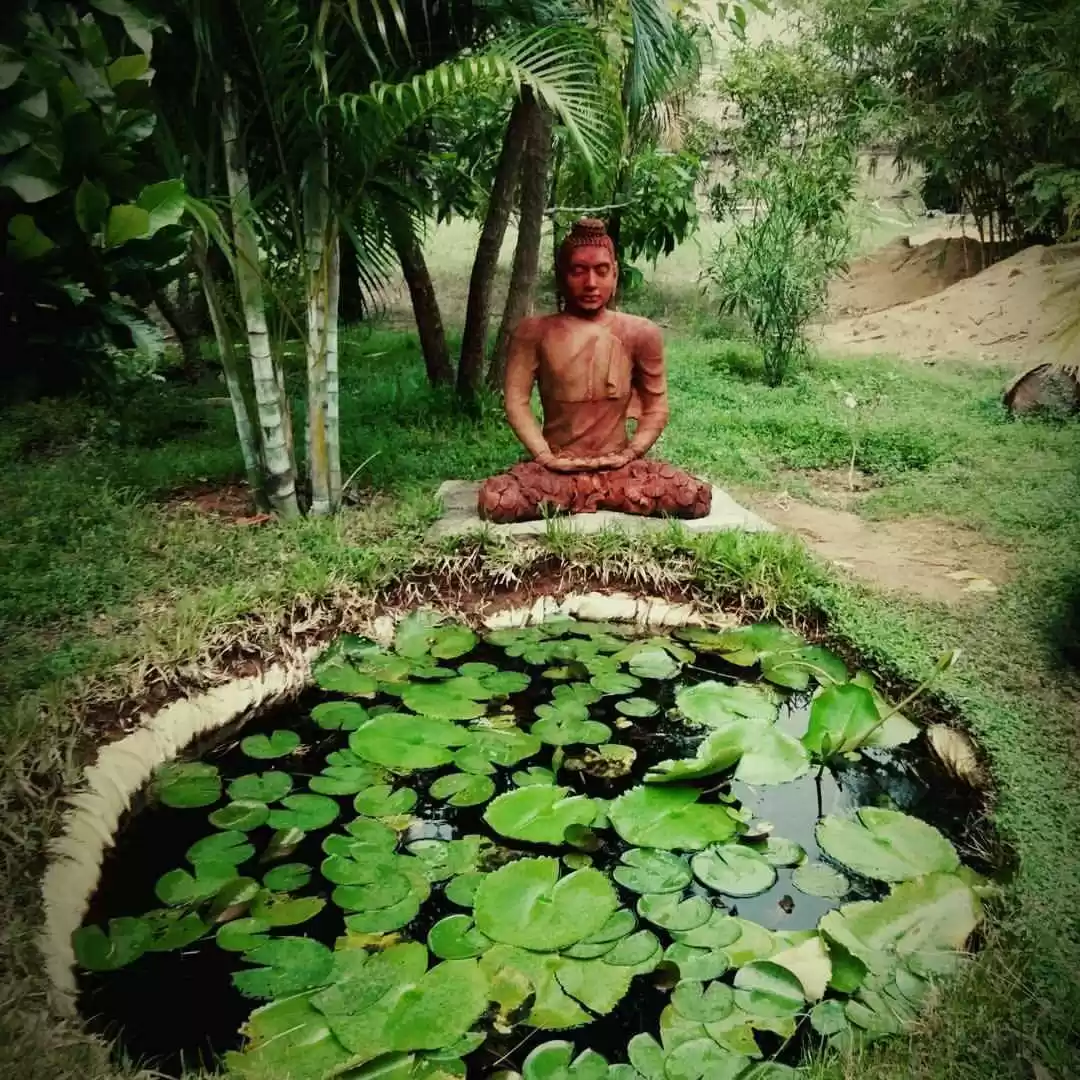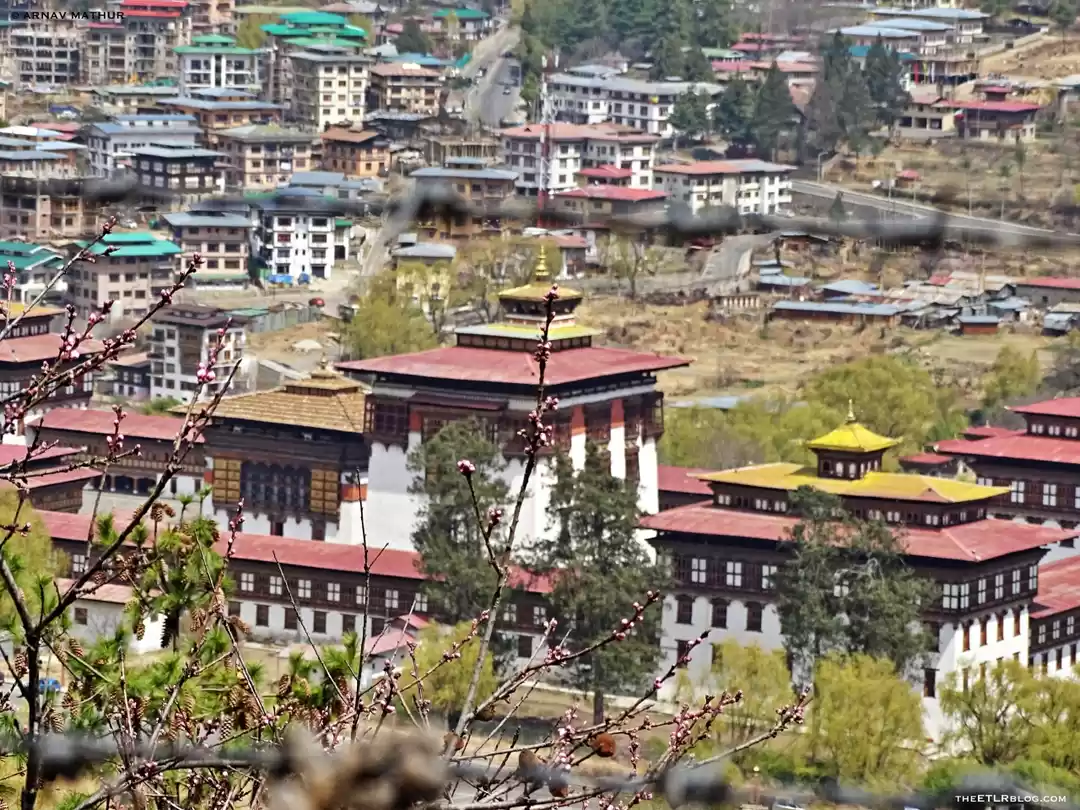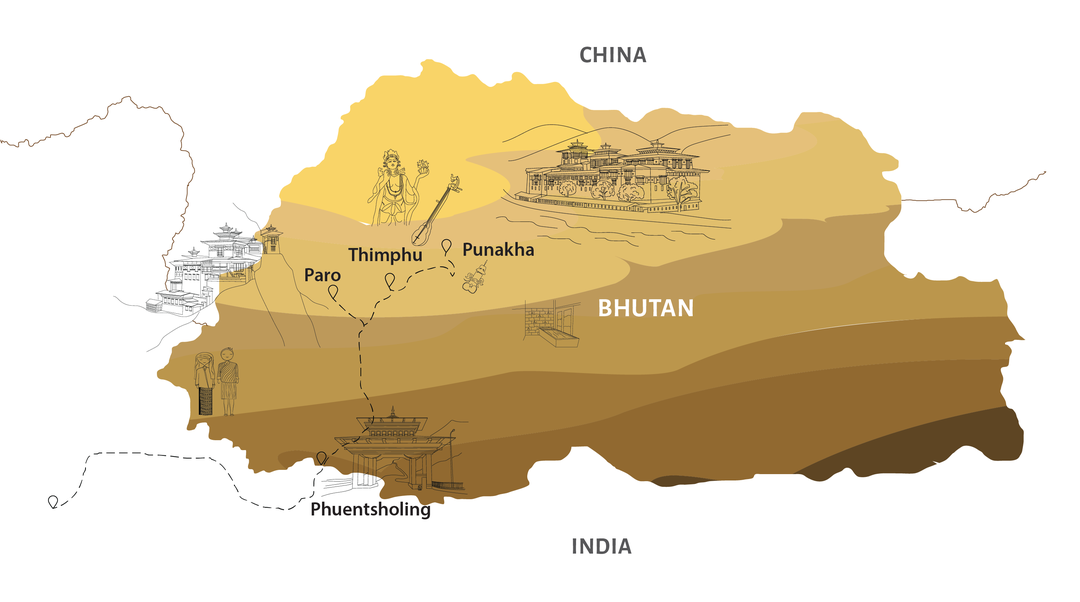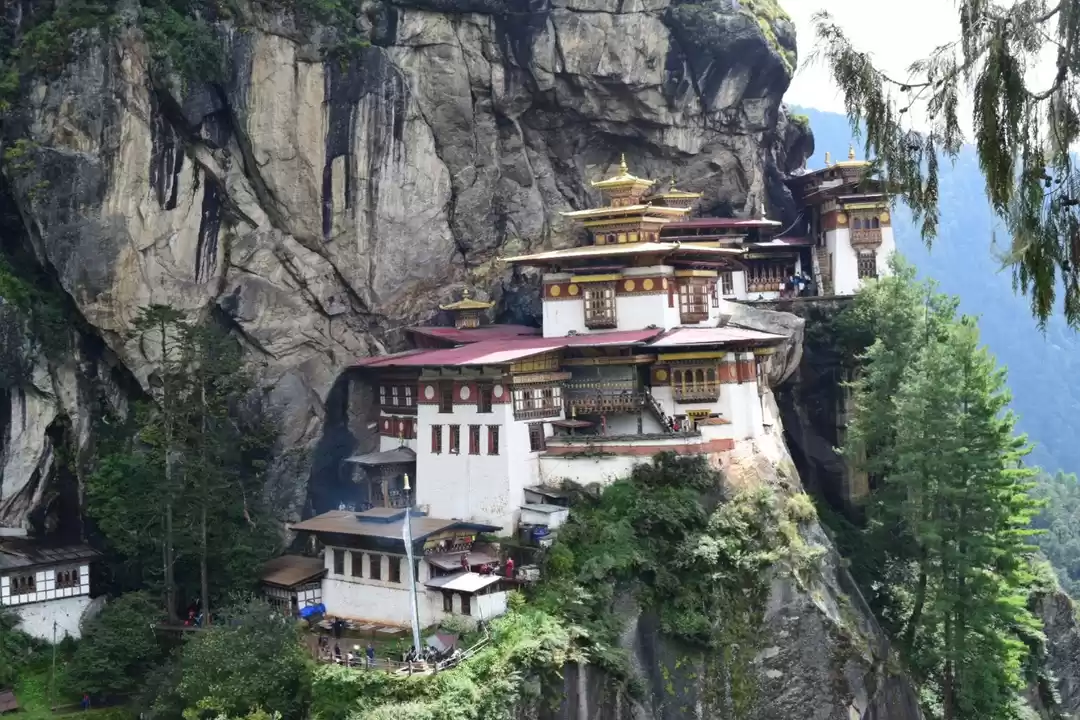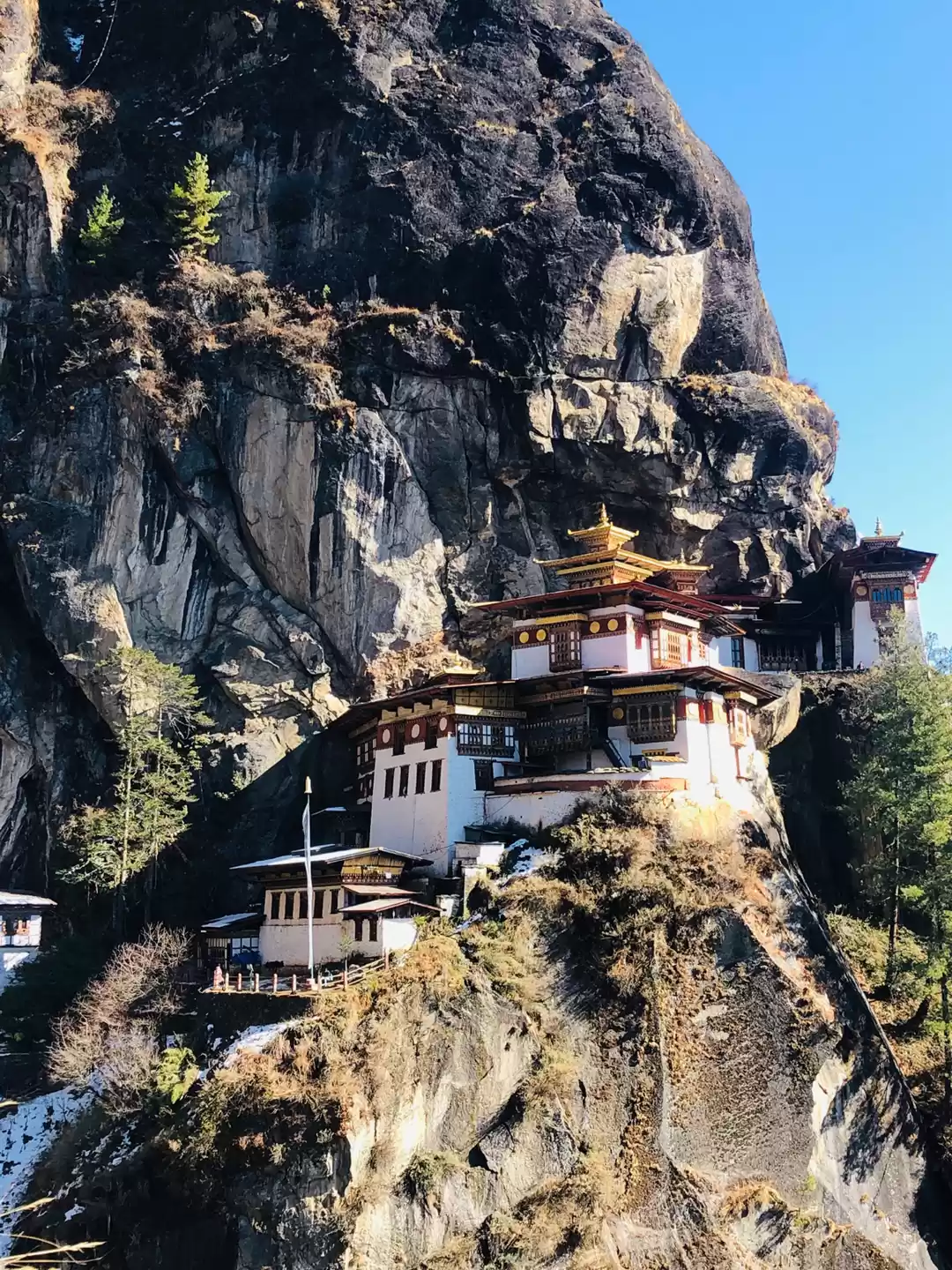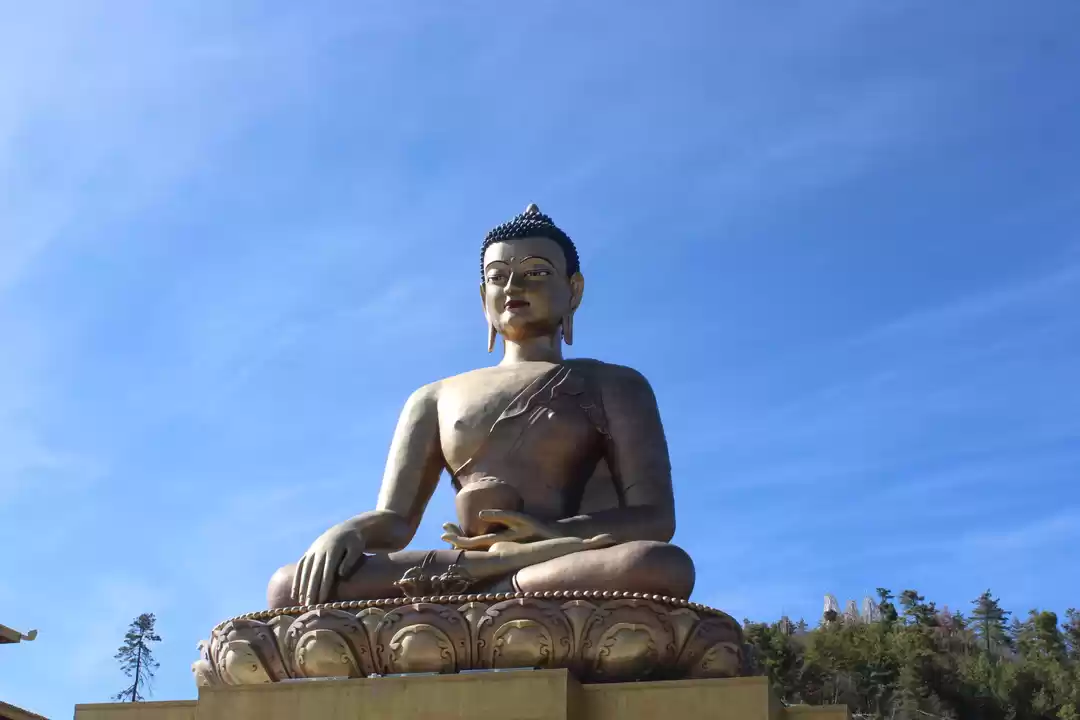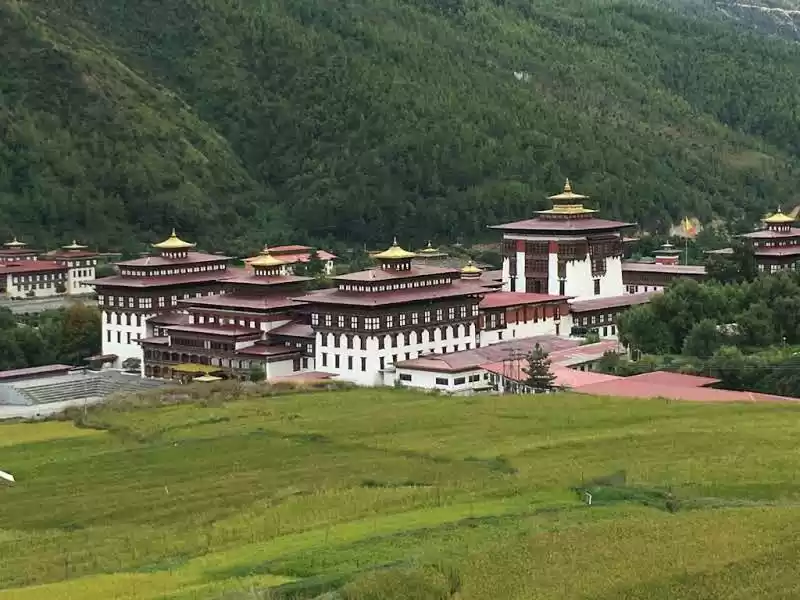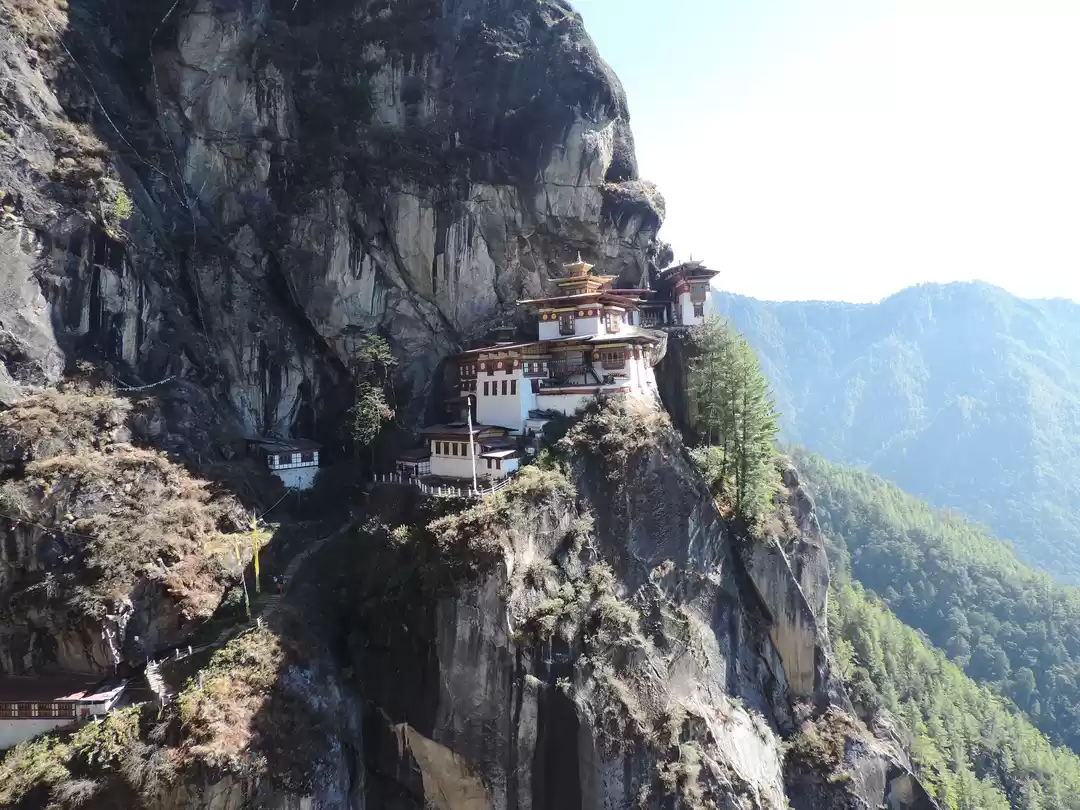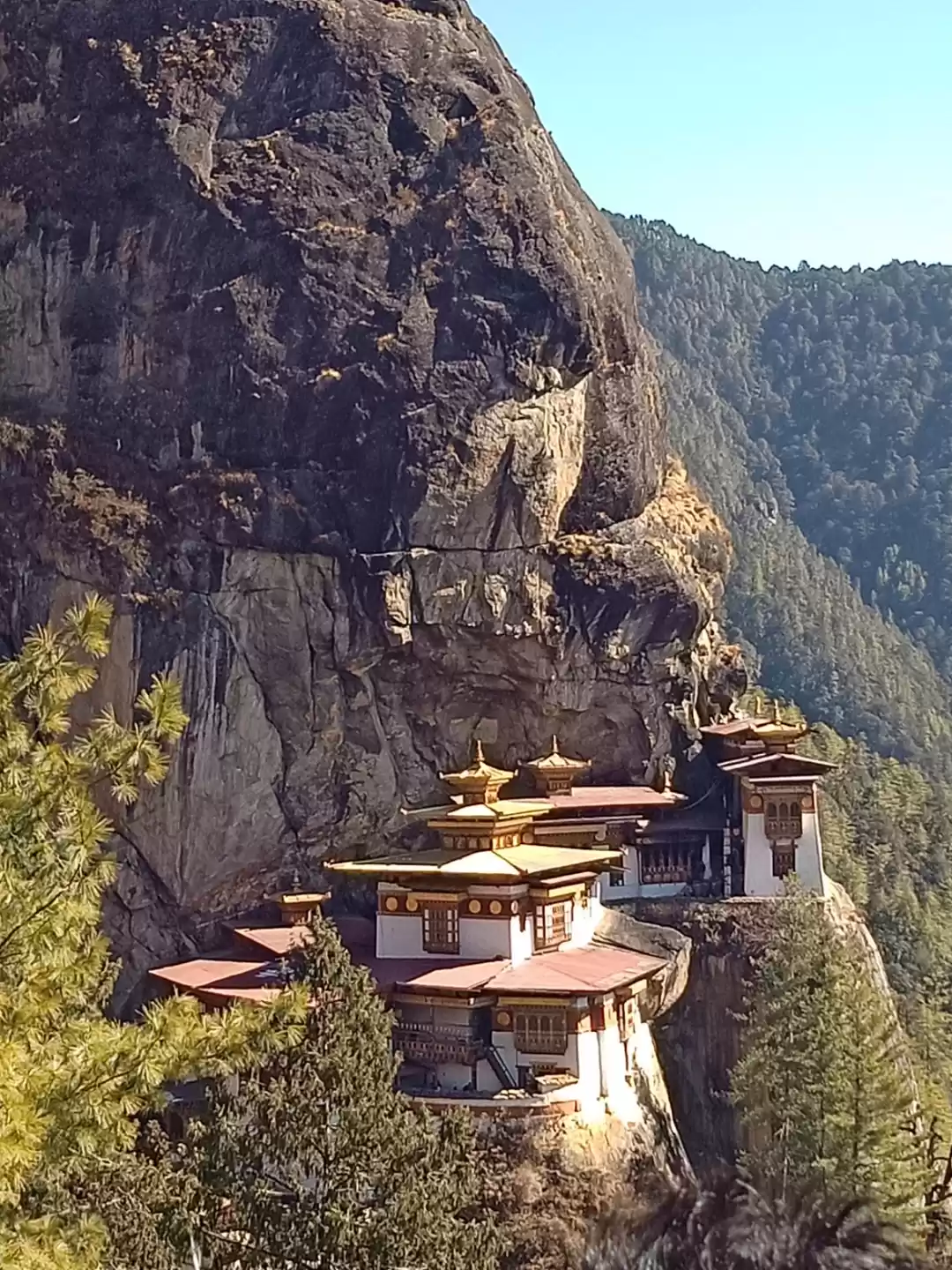I always wanted to visit this Royal Kingdom but due to my work profile, I was unable to get long leaves. But this time the destiny was with me, I clubbed my weekend with the long holidays and here I was in the lap of nature, Bhutan. Perched high in the Himalayas, Bhutan is a paradise for nature lovers. A country where rice is red and chillies are considered to be a vegetable, where development is measured not by Gross National Product, but by Gross National Happiness, Bhutan is the world’s last remaining the Buddhist Kingdom. A visit here will bring you face to face with ancient monasteries, fortresses (called Dzongs), ancient temples with prayer flags fluttering high, cleanliness, discipline and the warmth of its people.
I got a call from my college friend Sanjay that he is planning to visit Bhutan and if I wanna join in. Well, a fool will say no to this opportunity. I never plan trips they just occur to me and that’s why I am able to travel. So we had 7 days in hand but 7 days are still very less to cover all the popular places of Bhutan however, Sanjay managed to chalk out a 7-day itinerary covering the best places one can visit in Bhutan.
First things first, do you need a visa to visit Bhutan?
With the exception of visitors from India, Bangladesh and Maldives, all other visitors travelling to Bhutan need a visa. Indian, Bangladeshis and Maldivian nationals only need to obtain a permit at the port of entry on producing a valid passport with a minimum of 6 months validity (Indian nationals can also use Voters Identity Card). All other tourists need a visa clearance prior to the travel to Bhutan. Visas are processed through an online system or manually at the permit office. One requires a photocopy of the passport (photo page) who will then apply for your visa. The visa will be processed by the Tourism Council of Bhutan (TCB) once the full payment of your holiday has been transferred and received in the TCB bank account. Once received, the visa clearance will be processed within 72 working hours. At your point of entry, you will be required to show your visa clearance letter, the visa will then be stamped into your passport.
Getting permit processed online is better because you do not have to wait to apply for permit at the border town. The lines are usually very long and it takes a very long time to process your permit in peak season. And if you happen to arrive on a weekend, the immigration office remains closed and you will have to wait until Monday. Online processing is much convenient. All you have to do is submit your passport, hotel booking confirmation, and yes you will need to hire a local guide if you want to process your permit online.
We had planned our trip from 14th August to 20th August. Since I always travel in the budget so we chalked out our route plan via road as well as flight.
Day 1 – 14.08.2019
We have booked our flight tickets from Delhi to Bagdogra and return tickets from Bagdogra to Delhi. One can also take a direct flight to Paro from New Delhi but that was way costlier. The flight cost was just Rs. 7000 including the return journey to Bagdogra. I took an evening Shatabdi from Chandigarh and reached New Delhi on 13.08.2019. I stayed in my rest house and took the 10:05 AM flight from Delhi to Bagdogra on 14.08.2019. I reached Bagdogra at 12:20 PM and took a cab from the airport which costed me around 400 bucks to Siliguri. My other three friends were waiting for me in Siliguri as they have arrived one day earlier. We then hired an Innova for Rs. 5000 to Phuentsholing (Bhutan). No entry permit is required for Indian nationals for entering Phuentsholing City. The Phuentsholing border gate normally remains open from 6 am to 8 pm. One has to visit The Regional Immigration Office, Royal Govt. of Bhutan, Phuentsholing in person with 2 passport size photographs & passport/ Voter ID card to obtain entry permits for visiting Thimphu and Paro in Bhutan. Also, you need to attach the copy of your hotel booking in Thimpu/ Paro with your permit application. The permit is normally issued for one week. No fee is charged by Royal Govt. of Bhutan for issuing entry permits. However, tourists desirous of going beyond Thimphu and Paro need to acquire a ‘special area permit’ from the Immigration Office, Royal Govt. of Bhutan located at Thimphu on any working days (Monday to Friday) or one can get it through the local guides.
Indian currency notes of the denomination Rs. 2000 is not accepted in Bhutan so you must carry denominations less than Rs. 500. Bhutan’s currency is called as Ngultrum and is treated equally to Indian Rupee. We reached Phuentsholing at around 6:00 PM and then checked in our Hotel Phuentsholing and rested for the day.
Day 2 – 15.08.2019
Since it was not a peak season to visit Bhutan & also 15th August is not a holiday in Bhutan so we were quite sure that we would get a permit very easily. So we headed out to Immigration office early morning but to our surprise, the office was closed. The reason they told us was that Prime Minister of India is visiting Bhutan from 17th to 18th August so for the security reasons no permit is being issued. We tried every possible way to get the permit but we couldn’t. Then we thought of visiting Consulate General of India, Phuentsholing, Bhutan to help us out. Luckily we met the Consulate General of India at the entrance of his office and explained the whole story. But he also showed his inability to help us out as it was not in his hand but he asked us to accompany him for Independence day celebrations and told us that he will talk to us after the function. His facial expressions gave us the feeling that there was no hope of getting the permit. We were totally dejected as he was the only person in Bhutan who could help us out. We then went to witness the Independence Day Celebrations and enjoyed the various cultural performances given by the school students & students from various academies. After the celebrations were over I thought of trying once again to talk to him as there were 8 more people who were not able to get the permit. I along with some other tourists had a talk with him. He then tried to get us the permit and voila after 15 minutes he asked us to visit his office with our passports and photographs. His name is Ashish Middha, an IFS cadre Officer posted Consulate General of India, Phuentsholing, Bhutan. He is one of the most humble helpful diplomats I have ever seen in my life. We had lost all our hopes but he was the one who made all our hopes turning into reality. We thanked him for his kind gesture and went to our respective destinations thereon.
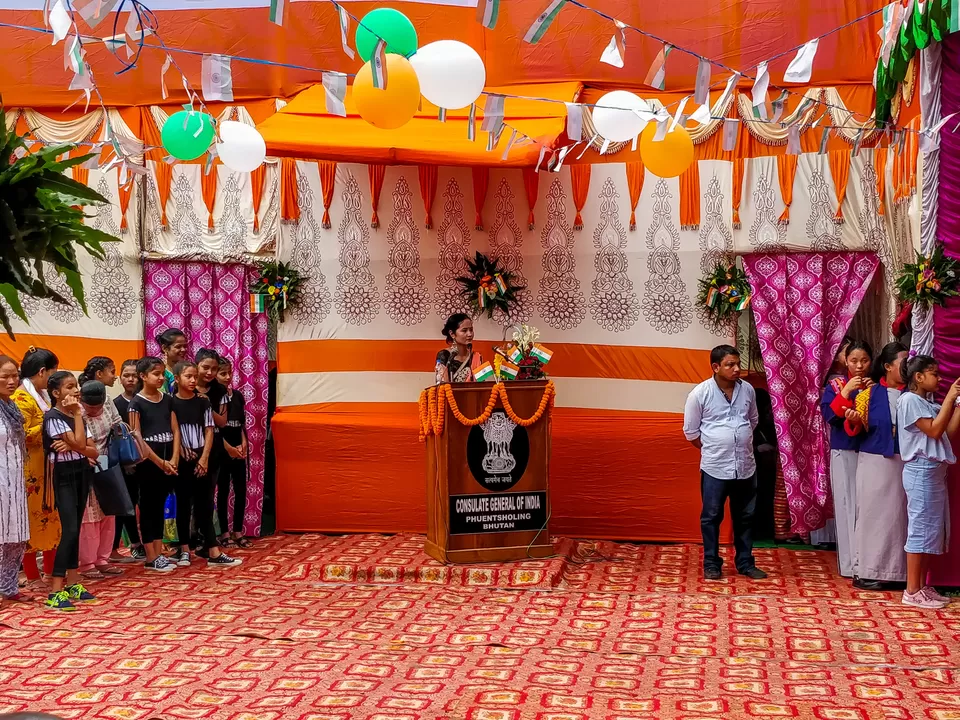
We then hired an Ertiga for 5 days costing around Rs. 15000. Karma Jamtsho, Contact No. – 17903810 was our guide and driver for next 5 days in Bhutan. We packed our bags and reached our first destination, Paro in the evening. Enroute we visited Ringchingding Monastery. Rinchending Goempa popularly known as Kharbandi Goempa is a monastery located just below the road on Phuntsholing –Thimphu Highway. It is located on a picturesque hill overlooking the whole Phuntsholing town and beyond Torsa River far into distant till the sight disappears into a mountain. The site serves as an ideal place to take pictures with the town and the mountains acting as a perfect background. The name of the Rinchending Goempa literally translates to a monastery on a precious hill. The monastery was built in 1960s by the great grandmother Ashi Phuntsho Choden Wangchuck to the present King. The monastery houses great statues of Guru Rinpoche, Buddha and Zhabdrung Ngawang Namgyal.
The unique thing about Bhutan is that every new town/ district has a huge entrance gate made in traditional Bhutanese architecture welcoming you. Yes, Your passport gets checked every time you cross immigration check posts and do remember to get it stamped during the return journey as well. Finally, we reached Paro in the evening. The Paro town looks beautiful at night with all Dzongs and Entry gates lighten up with heavenly lights.
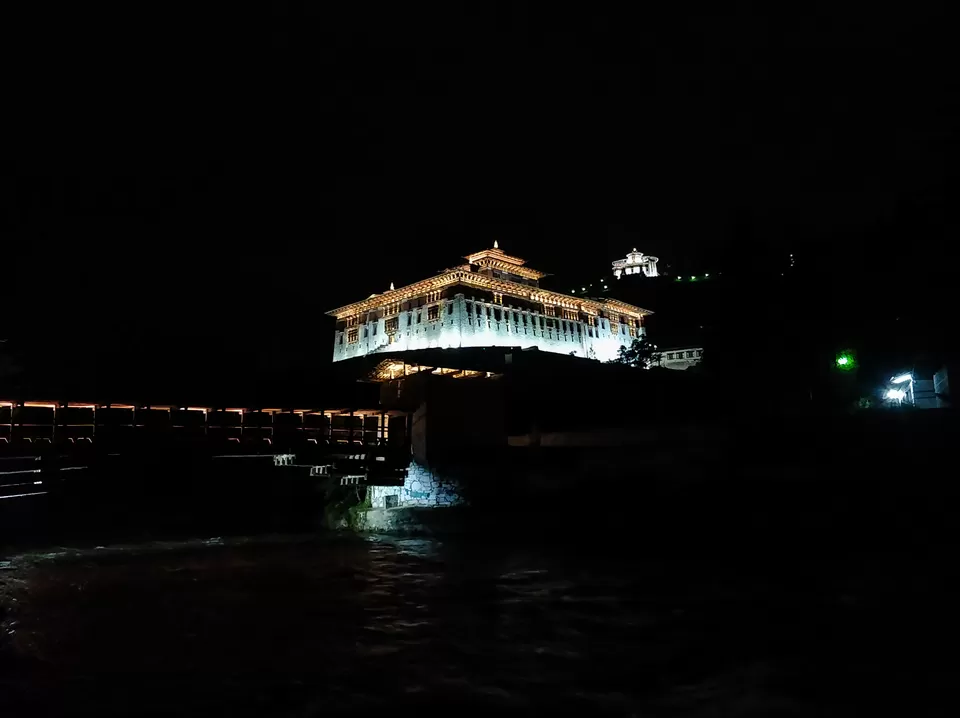
We checked in our first home stay Namgay’s Home stay. They served us with authentic Bhutanese food. Actually, every home stay in Bhutan has mainly Bhutanese food available. It is very difficult to find out Indian food in Home stays. Personally, I didn’t like the taste of the food as it was cooked in Cheese and was quite different in taste than my regular meals. Also, the room was simple nothing fancy, rather our Hotel which costed us Rs. 4500 was much luxurious than the home stay which costed us Rs. 5500. But yeah, I can’t complain as it was a home stay, not a hotel. They have a cute dog and a cat as pets.
We played for some time with them and after dinner, we went for a stroll at night. The home stay is located in a quiet and beautiful farmland of Paro. If you are looking for a place that is close to the main city but also offers an escape from the hustle and bustle of cities, Namgay Home stay can be on your list. There are more home stays in this area as well. The place boasts of serenity and has the river Dop-chu running nearby making it a gorgeous landscape outside. The most striking feature of the home stays in Paro is the traditional hot stone bath and the relishing Bhutanese meals that one can enjoy here (I have some taste buds issues..hahaha..) but you will definitely enjoy the meal. The place is one of the best places where you can enjoy the homely vibes and have an idyllic getaway by enjoying the tranquil ambiance all around.
Day 3 – 16.08.2019
The very next day early in the morning we left for our trekking destination Paro Taktsang known as Tiger’s Nest. The Tiger’s Nest hike is one of the most popular hiking trails in Bhutan as it leads you to one of the most unusual and beautiful spots in the world – the Tiger’s Nest Monastery. This unique building site is a fascinating and surreal experience, not to mention the beauty of the location itself. The Tiger’s Nest Monastery is a sacred Buddhist temple and monastery that was built on a cliff-side in the Paro Valley. The monastery sits at a remarkable height of 900 meters (2995 feet) above sea level and is still a functioning monastery. There is an entry fee of Rs. 500 per person to visit the temple complex. The temple was built around the cave in which Guru Padmasambhava, the “second Buddha”, meditated and first introduced Buddhism to Bhutan. Traditional beliefs tell a tale of the Guru having flown from Tibet to the cave on the cliff on the back of a flying tigress to subdue a demon in its lair on the mountain. Since then, he established himself on the summit and was revered and worshiped. The shrine itself, however, was first built about nine centuries later, and subsequently rebuilt many times.
The Hike
The hike to Tiger’s Nest is a moderate to difficult one but you’ll be able to do it if you have at least an average level of fitness. The hike takes between 3 to 5 hours depending on your pace. Some parts are quite steep so go slow and be sure of your footing – especially when you make the return trip downhill which can be quite slippery. The path started off innocuously enough amid rocks and boulders and a gentle slope. On either side were masses of tall pine and cypress trees draped in tender green moss, and filled with chirping birds, making for a fabulous backdrop to the climb. The hike is about 6 km in length round trip. For people who cannot make the climb, there are horses available for hire at the starting point. Also, the stalls at the starting point of the hike sell walking sticks which can be very helpful along the hike. They are especially useful on the descent as they can help you keep your balance and prevent you from slipping. One must take plenty of water and some snacks along the trek to stay hydrated & keep the energy levels up. While the trail is not steep, it is uphill the whole way. There is a cafeteria at the halfway mark, where you can take a break to catch your breath and eat something to keep your energy levels up. You’ll mainly find Bhutanese food here. From this point, one can see a clear view of the monastery and take some beautiful photos of it.
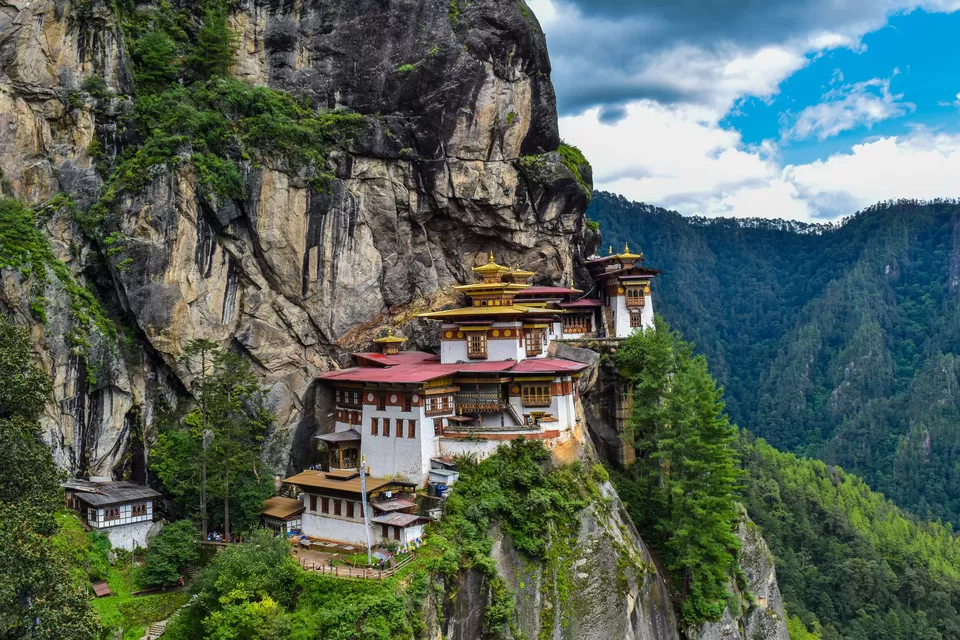
The trail levels out for a while after the halfway point, making the second half of the hike a bit easier and less strenuous than the first. As I slowly gained altitude, the winding path suddenly turned a corner and opened up stunning, panoramic views of the verdant valley in front and hills in the distance. It is an excellent photo point and one can see a closer view of the entire monastery as it perches on the steep cliff. The last section of the trail includes a series of about 700 stone steps that you will need to journey along. One has to walk down the stairs at first, then cross a bridge, and finally, you’ll start climbing the stairs up to the monastery. This is the real challenging part of the hike so be sure to take your time, it’s not a race to the top.
The Monastery
The monastery buildings consist of four main temples and residential shelters ideally designed by adapting to the rock (granite) ledges, the caves and the rocky terrain. Out of the eight caves, four are comparatively easy to access. The cave where Padmasambhava first entered, riding the Tiger, is known as ‘Tholu Phuk’ and the original cave where he resided and did meditation is known as the ‘Pel Phuk’. He directed the spiritually enlightened monks to build the monastery here. The monastery is so precariously perched that it is said: “it clings to the side of the mountain like a gecko”.
The main cave is entered through a narrow passage. The dark cave houses a dozen images of Bodhisattvas and butter lamps flicker in front of these idols. An elegant image of Chenrezig (Avalokitesvara) is also deified here. In an adjoining small cell, the sacred scripture is placed; the importance of this scripture is that it has been scripted with gold dust and the crushed bone powder of a divine Lama. It is also said that the monks who practice Vajrayana Buddhism (the formal State Religion of Bhutan) at this cave monastery live here for three years and seldom go down to the Paro valley.
All the buildings are interconnected through steps and stairways made in rocks. There are a few rickety wooden bridges along the paths and stairways also to cross over. The temple at the highest level has a frieze of Buddha. Each building has a balcony, which provides lovely views of the scenic Paro valley down below. The Monasteries have an ancient history of occupation by monks, as hermitages.

You can enter the temple, after taking off your sunglasses, caps and shoes. Backpacks, cameras, and cell phones are not allowed inside the temple premises. There are lockers available at the entrance to keep your stuff. After keeping our backpack we were taken by a guide to give the tour of the temples. The guide explains to you about the history and all the fascinating legends associated with the monastery. While it can get pretty cold in the winter, you’ll start to feel hot as you hike, so layers of light clothing is the best option. You’ll need light layers that you can remove and carry with ease because you don’t want to be carrying around a heavy winter jacket and not end up needing it. Remember it is a sacred site so no shorts or revealing tops are allowed inside the temple premises. The temple complex is very quiet, silence prevails all around. Monks can be seen meditating.
Finally I after visiting the monastery we started our descent. The weather changed from sunny to overcast and it started raining heavily. I stopped for some time but there was no sign of rain getting stopped. Luckily I had an umbrella which somewhat helped me out and I reached the cafeteria. We had some snacks and waited for the rain to get subside.It stopped raining, Sanjay shouted let’s leave it now. We again started our descent, we slipped and slithered a bit, and we laughed a lot, regaling each other with stories and hilarious anecdotes. By the time we reached the starting point, the mini-market was in full swing. Run mostly by women, the shops offered a plethora of souvenirs and handicrafts that were typically Bhutanese and the women were vociferous in trying to attract customers. We completed our trek by 12:30 PM.
National Museum of Bhutan
The next on our list was the National Museum of Bhutan. Perched above Paro Dzong is its ta dzong (watchtower), built-in 1649 to protect the undefended dzong and renovated in 1968 to house the National Museum. The unusual round building is said to be in the shape of a conch shell, with 2.5m-thick walls. The ta dzong suffered damage in the 2011 earthquake but reopened in 2019 as the nation’s premier museum. The museum temporarily has been transferred to a nearby site. Presently there are 3 rooms of exhibits.
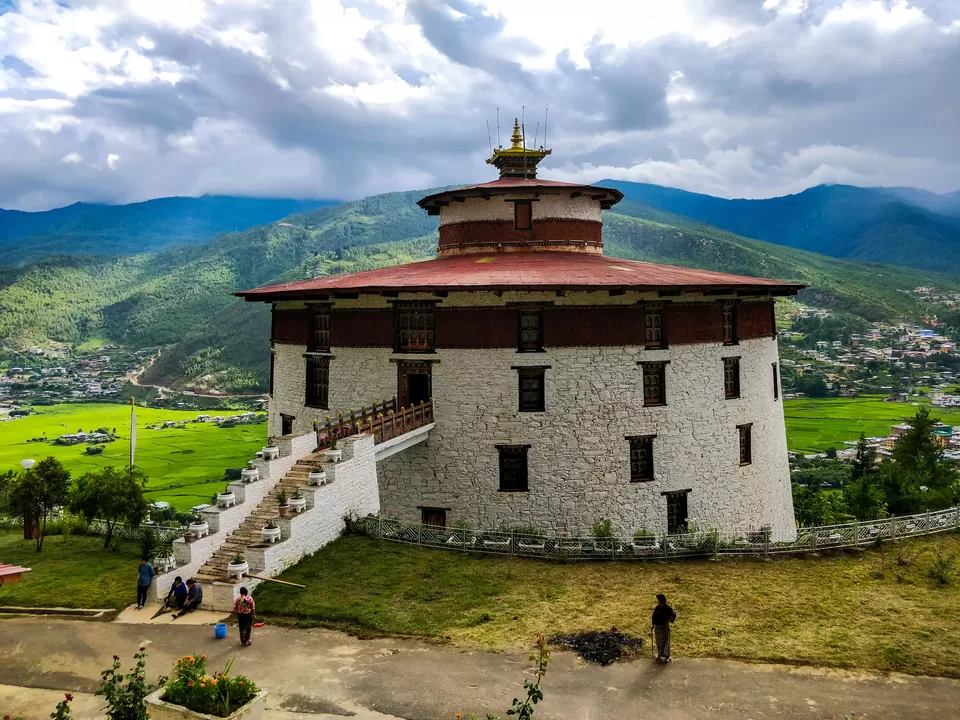
The museum tours through the history of Bhutan, their culture and tradition. We got to know about the species of birds and animals found in Bhutan. A well-preserved skin of a clouded leopard, crocodile, Chinese pangolin, leopard and gharial has been kept in the museum. The museum is well maintained and celebrating 50 years of friendship with India. Adjacent to the museum is the original one which is being restored and due to open. This original museum was earlier used as a watchtower for the Paro Dzong.
The Museum has a collection of ceremonial masks and their explanations and is very well curated along with a short documentary on each section. The photo gallery of the Royal Family of Bhutan is also very informative. The section on the natural flora and fauna of Bhutan is documented and displayed very well. If you enjoy culture and history then it’s a must-visit destination in Paro. No photography is allowed inside the museum. There is a Government-run souvenir shop inside the museum. Masks, Scrolls, Thangka and other traditional Bhutanese items can be purchased at lower prices than the open market.
We then went to explore the markets of Paro. The markets usually have handicrafts of traditional Bhutanese culture such as Hand-woven textiles, bronze statues, Buddhist sculptures and paintings, souvenirs, Thangkas, Colourful Carved Masks etc. We purchased some souvenirs and left for Thimpu in the evening and reached our Hotel Bhutan in the evening. We had a relishing dinner and went out for an evening walk. The markets in Bhutan usually close by 9:00 PM. We visited the lively Clock Tower Square in the city centre had some Bhutanese beer. We then called the day off.
Day 4 – 17.08.2019
This day we had kept for exploring the capital of Bhutan, Thimpu. We started early so as to cover maximum places. We had a number of sites lined up to be visited today.
Memorial Chorten
The first on our list was Memorial Chorten. The architecture of the Chorten has been designed to present it as “one of the most visible religious structures in Thimphu”.
The Memorial Chorten, in the heart of the city, is designed is a Tibetan style Chorten, also called the Jangchup Chorten, patterned on the design of a classical stupa, with a pyramidal pillar crowned by a crescent moon and sun. The feature that is distinct here is the outward flaring of the rounded part to give the shape of a vase (a pyramidal shape), unlike a dome shape. The Chorten depicts larger than life-size images of wrathful deities with their female consorts in large numbers.
Buddha Dordenma
Great Buddha Dordenma is a gigantic Shakyamuni Buddha statue in the mountains of Bhutan celebrating the 60th anniversary of fourth king Jigme Singye Wangchuck. The statue houses over one hundred thousand smaller Buddha statues, each of which, like the Great Buddha Dordenma itself, are made of bronze and gilded in gold. The Great Buddha Dordenma is sited amidst the ruins of Kuensel Phodrang, the palace of Sherab Wangchuck, the thirteenth Desi Druk, overlooking the southern approach to Thimphu, the capital of Bhutan.
The statue also fulfils two prophecies. The first, foreseen by yogi Sonam Sangpo, is that a Buddhist statue would be built in the region to “bestow blessings, peace, and happiness to the whole world.” In addition, the statue is said to have been mentioned by Guru Padmasambhava, widely referred to as the “second Buddha,” in the eighth century. This statue kills two birds with one stone by fulfilling both prophecies in glimmering fashion.
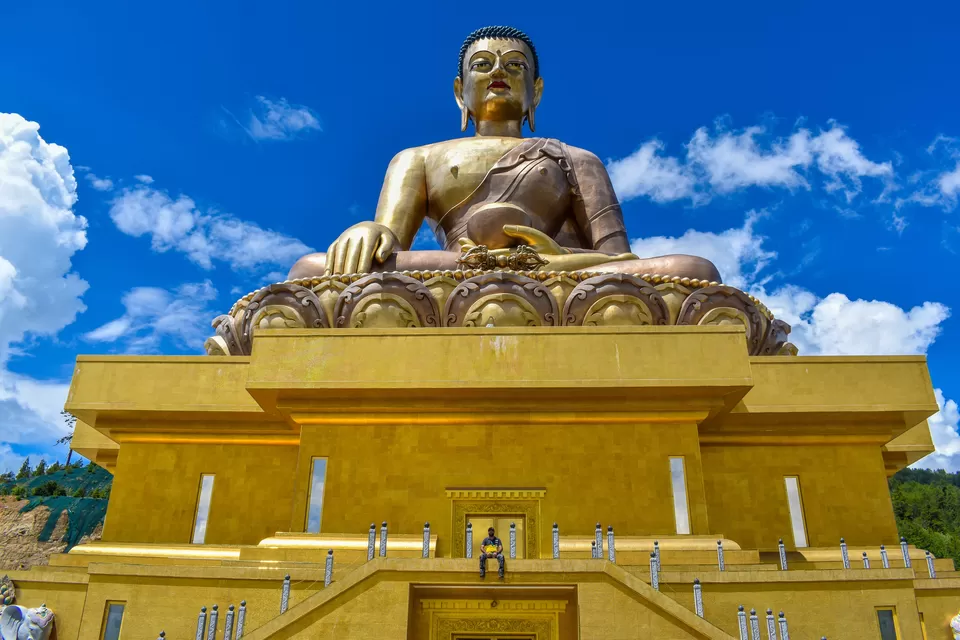
Simply Bhutan
Simply Bhutan is a museum resembling a Bhutanese village, featuring traditional cuisine, demonstrations & performances that aims to conserve the Bhutanese culture and tradition while generating employment opportunities for young job seekers. The infrastructure portrays ancient Bhutanese architecture which is being lost to modernization. The project is one of its kind in the country. The uniqueness of the structure is in its composition of the materials used. The structure is built reusing old timber, window and door frames and other items from traditional and old demolished houses. The best part is the portrayal of the age-old lifestyles of the Bhutanese people.
You are received in the reception room with local wine. The local guides explain to you about a lot of things around the room. I met Pema, our guide in simply Bhutan who explained us all about the museum and its features.
After the reception, you enter the Bhutanese kitchen which still follows traditional methods. At Simply Bhutan all the traditional ways of cooking meals and making beverages are used. There are utensils used by the ancestors to prepare all the authentic Bhutanese dishes.
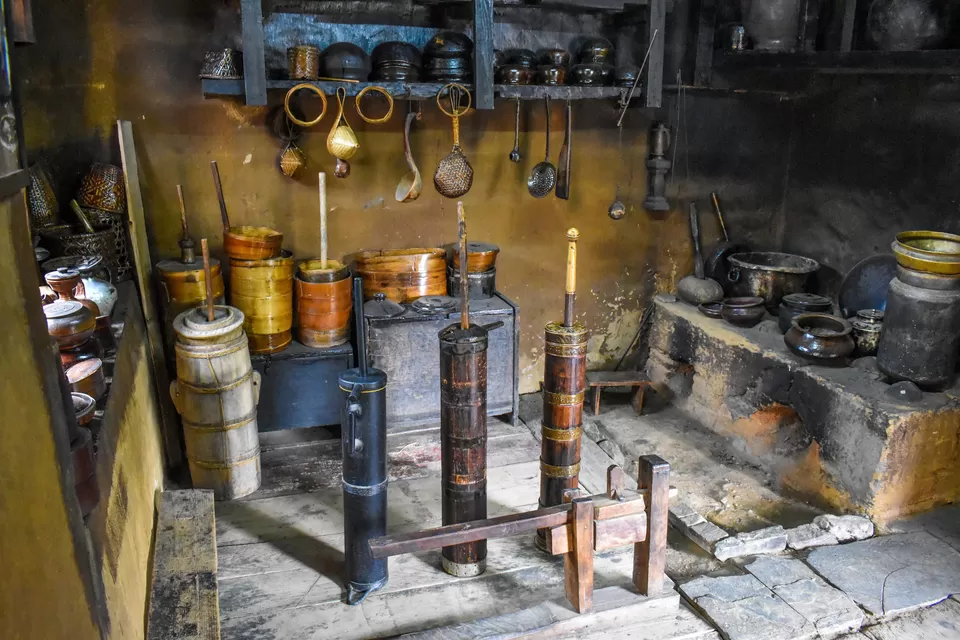
Buddhism first arrived in Bhutan in the 8th century. It then began to spread over the next few centuries. In the 15th century, a Tibetan monk named Drukpa Kunley arrived and helped to spread the religion even further. He has remained one of Bhutan’s most revered Buddhist masters to date. Although he simplified religious texts for the laypeople of his adopted country, Drukpa Kunley’s claim to fame goes beyond this task. He is actually known for a more notable skill, using imagery of the phallus to subdue demons and bless the people of Bhutan. The Phallus Garden is the most unique thing you’ll see in Simply Bhutan.
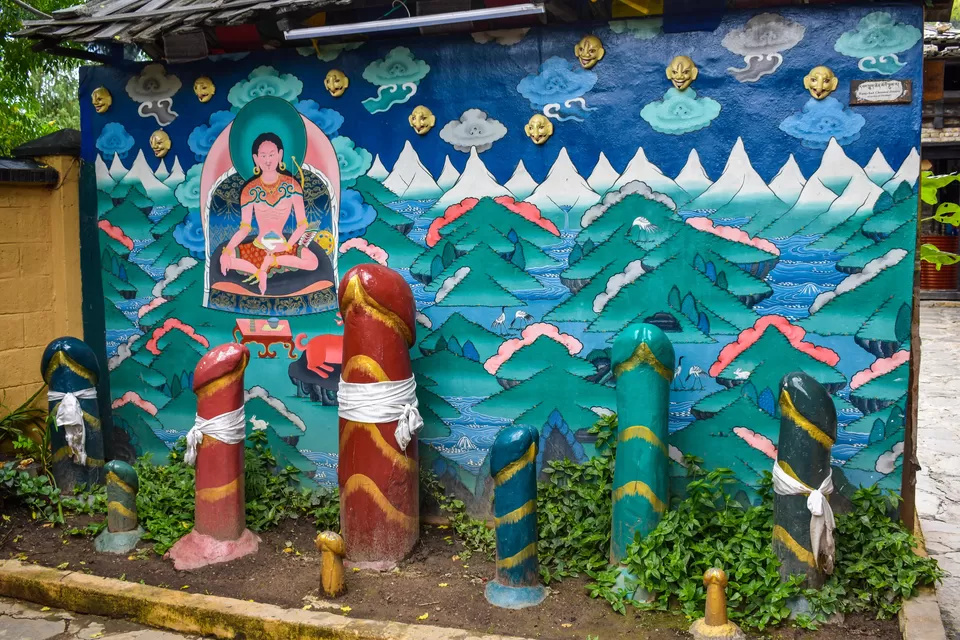
The traditional food storage techniques are displayed. The art of dry storage is mostly followed in modern life as well. This method of storing dry food for winter is very efficient as winter in Bhutan can be quite harsh. We can store varieties of food such as chillies, pumpkin, maize, cheese, bringle, apple etc are stored.
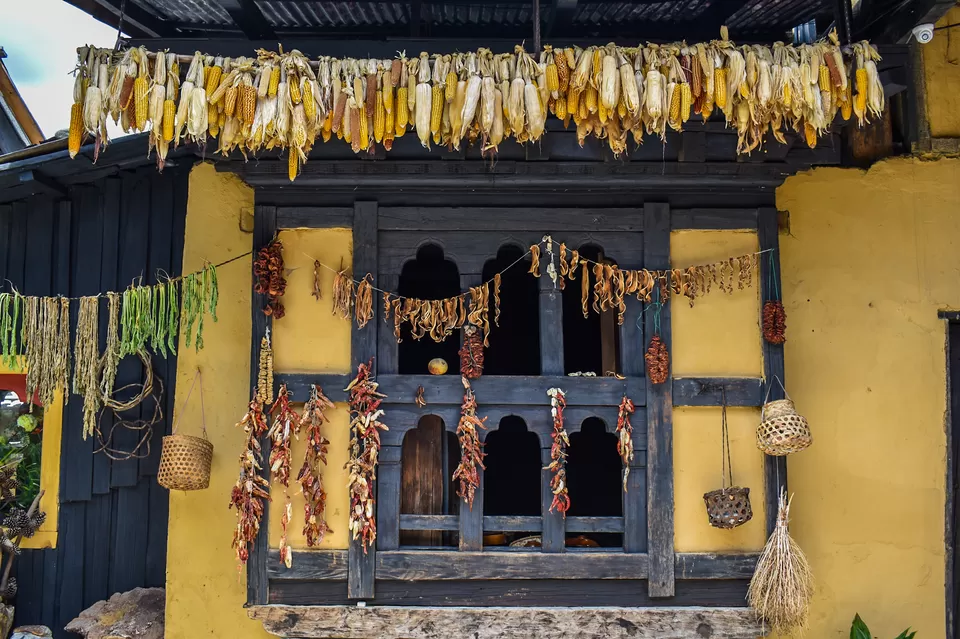
At Simply Bhutan typical Bhutanese dishes prepared by the local chefs. The dishes that are served are red rice with your choice of Bhutanese side dishes. Also, you are served with freshly churned butter tea suja and Bhutanese dance performances.
Pema Tshering: An Inspiration
How many of us can see the talents of people with disability What comes to our mind when we see that not only can’t he talk but he can’t walk as well. Many of us would totally give up on his disability. Many of us would have just put him in the corners of our houses and left him there. We would feed and cloth him but never look beyond. Her Majesty the Queen Mother came across Pema several years ago on Her Royal tour to Eastern Bhutan. He waited in the sun all day to offer Her Majesty a present. Her Majesty brought him to the capital and blessed him with an opportunity. Today, after attending the training at the Institute for ZorigChusum, He makes very beautiful carving on wood. And he does it with his LEGS. Youth Development Fund, Bhutan has given him a place to work and sell his products in Simply Bhutan.
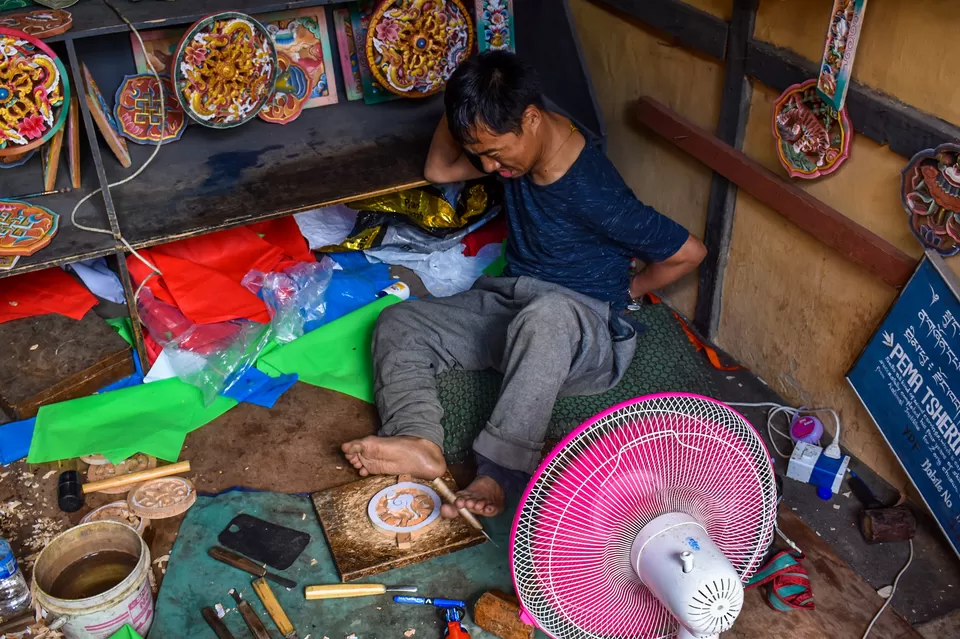
Since time immemorial Bhutanese have been passionate about their national sport of Dha (archery). Nearly all villages in the kingdom boast an archery range and each dzong has a space set aside nearby. There is a small Archery set up for visitors to gets hands-on this sport. We tried our skills at archery and even the Bahubali Style.
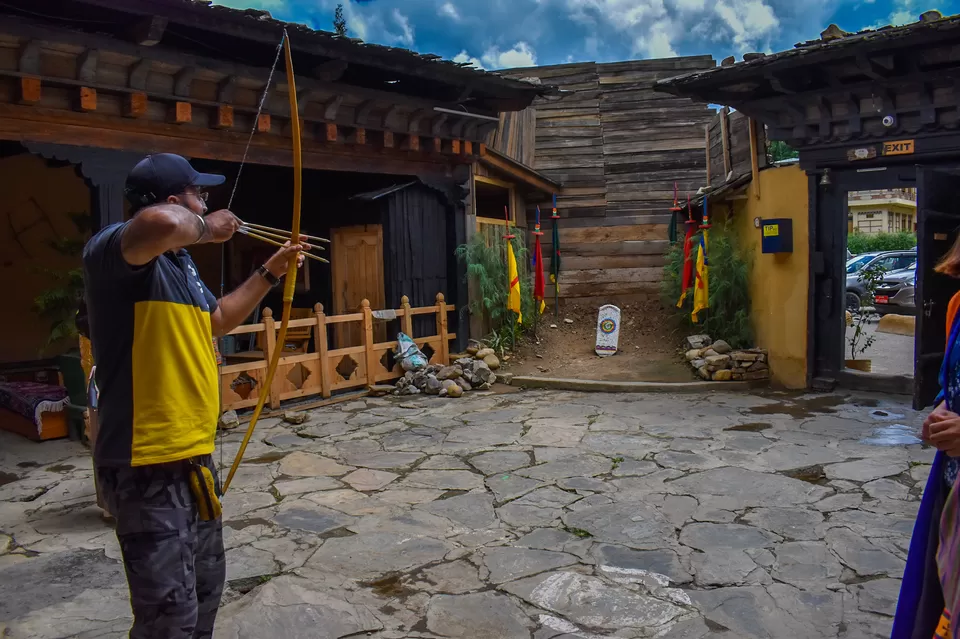
At the exit point, Tashi Delek greets you. There is a sacred pond in which you have to throw coins and wish something for you. Tashi Delek offers you blessings and good luck.
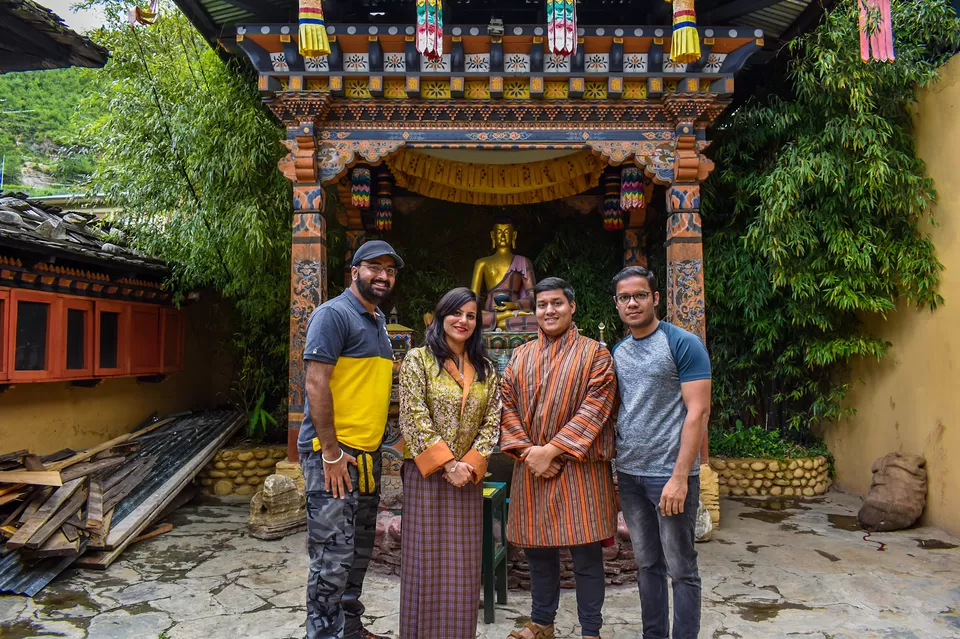
At Simply Bhutan you get to wear the traditional Bhutanese dress which is completely unique as compared to the modern world. The men wear gho and the women wear kira. There is a dressing room where you can experience the Bhutanese culture of dresses.
Motithang Takin Preserve
Bhutan trip cannot be considered complete without visiting the Takin Preserve. Nestled in the woods and away from the nuisance of the city, Motithang Takin Preserve is Perched at an altitude of 2500ft. Motithang Takin Preserve is bewitched with a dense alpine forest that you must explore while you are in Bhutan. It is situated on the outskirts of Thimphu Valley and is dedicated to preserving the national animal of Bhutan, ‘Takin’. Motithang Takin Preserve serves as a hub of Bhutan’s national animal, Takin.
Takin is a rare type of goat-antelope animal living in the Eastern Himalayas which is a result of convergent evolution. With elongated noses, broadheads, and bulky torsos, Takin holds a distinctive look in appearance. All the biologists are all keen to study the creature because though it resembles like muskox, it’s actually genetically similar to sheep. A dedicated team is committed to ensure that the environment is congenial for these mammals. A well-maintained footpath through the woods takes tourist around the zoo. The synergy of the gentle stream flowing adjacent the footpath and quiet surrounding rewarded us with a refreshing walk.
The day was tiring as we had completed major attractions of Thimpu. We then reached our hotel back had some snacks and then again went out to enjoy the nightlife and do some shopping.
Day 5 – 18.08.2019
Though we had covered all the main places yet we haven’t seen one thing – The Dzongs. So this day we started our journey by visiting Simtokha Dzong. About 5km south of Thimphu on the old road to Paro and Phuentsholing, the handsomely proportioned Simtokha Dzong was built in 1629 by Zhabdrung Ngawang Namgyal. The site is said to mark the spot where a demon vanished into a rocky outcrop, hence the name Simtokha, from simmo (demoness) and do (stone). The site was also a vitally strategic location from which to protect the Thimphu valley and the passage east to the Dochu La and eastern Bhutan.
Simtokha is often said to be the first dzong built in Bhutan. In fact, there were dzongs in Bhutan as early as 1153, but this was the first dzong built by the Zhabdrung and was the first structure to incorporate both monastic and administrative facilities. It is also the oldest dzong to have survived as a complete structure. Just above the dzong is Bhutan’s Institute for Language and Culture Studies.
During its construction, Simtokha Dzong was attacked by an alliance of Tibetans and five Bhutanese lamas from rival Buddhist schools who were opposed to the Zhabdrung’s rule. The attack was repelled and the leader of the coalition, Palden Lama, was killed. In 1630 the Tibetans attacked again and took the dzong, but the Zhabdrung regained control when the main building caught fire and the roof collapsed, killing the invaders. Descriptions of the original buildings at Simtokha Dzong were provided by two Portuguese Jesuit priests who visited in 1629 on their way to Tibet.
The fortress was restored and expanded by the third desi (secular ruler), Mingyur Tenpa, in the 1670s, and it has been enlarged and modified many times since. The fine murals inside have been restored by experts from Japan. The squat, whitewashed dzong looks more fortress-like than most, and the only gate is on the south side (though the original gate was on the west wall). As you enter, note the murals of the four guardian kings – Vaishravana (north), Dhritarashtra (east), Virudhaka (south) and Virupaksha (west) – protecting the four cardinal directions, and the jewel-vomiting mongoose in the hand of the yellow King of the North.
The utse (central tower) is three storeys high, and prayer wheels around the courtyard are backed by more than 300 slate carvings depicting saints and philosophers. The large central figure in the central Lhakhang is of Sakyamuni, flanked by the eight bodhisattvas, and the ceiling is hung with an incredible array of dhvaja (victory banners) in brightly coloured silk. The dark murals inside this Lhakhang are some of the oldest and most beautiful in Bhutan and the walls are adorned with embroidered thangkas (religious pictures).
In the western chapel are statues of Chenresig, green and white Taras, and an early painting of Zhabdrung Ngawang Namgyal. Do check out the tigers’ tails and guns hanging from the pillars in the eastern goenkhang, a protector chapel dedicated to the guardians of Bhutan, Yeshe Goenpo (Mahakala) and Pelden Lhamo.
After visiting Simtokha Dzong we then moved to our next destination, one of the highest and beautiful locations in Bhutan Dochula Pass.
Dochula Pass
The Dochula Pass is a mountain pass in the snow-covered Himalayas within Bhutan on the road from Thimpu to Punakha where 108 Memorial Chortens or stupas known as “Druk Wangyal Chortens” have been built by Ashi Dorji Wangmo Wangchuk, the eldest Queen Mother. Apart from the Chortens, there is a monastery called the Druk Wangyal Lhakhang (temple), built-in honour of the fourth Druk Gyalpo (head of the state of Bhutan), Jigme Singye Wangchuck the open grounds in its front yard is a venue for the annual Dochula Druk Wangyel Festival. The pass with 108 memorial Chortens is adjacent to the country‘s first Royal Botanical Park. The pass is located at an elevation of 3,100 metres (10,200 ft) on the East-West Road from Thimpu to Punakha and further east in the Himalayas amidst the Eastern Himalayan snow-covered mountains. To the east of the pass, the snow-clad mountain peaks of the Himalayas are seen prominently and among them is the Mt. Masanggang at 7,158 metres (23,484 ft) which is the highest peak in Bhutan, known in local language as the Mt. Gangkar Puensum. The weather at the pass was quite foggy and chilly. However, between October and February, panoramic views of the Bhutan Himalayas can be seen.
The forest cover on the slopes of the pass consists of cypress trees. The hill slopes around the pass are festooned with a profusion of colourful religious flags fixed by the Buddhist people as a mark of veneration. The flags, made in five colours representing the natural forces, — “blue (sky), white (clouds), red (fire), green (water) and yellow (earth)” – are inscribed with Buddhist scriptural prayers to usher prosperity and peace around the country.
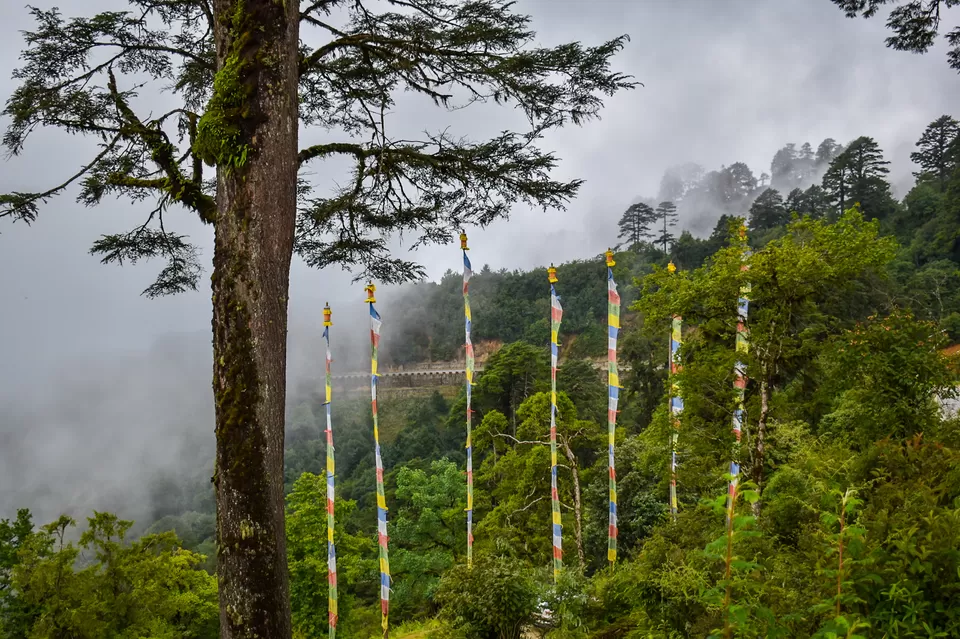
After the Losar festival in February, which marks the Bhutanese New Year the pass provides a spectacle of many species of flowers such as the Primal Denticulata, Primula Garcilipes and in the subsequent month rhododendrons bloom in profusion. Magnolia campbellii also bloom on the pass during this period. Another fragrant plant, which people come to enjoy, is the Daphne which is a small shrub which blooms with white flowers amidst an array of prayer flags that are fixed on the slopes. The bark of this plant is used to make paper which is a traditional paper used for writing religious scriptures as it is termite-free.
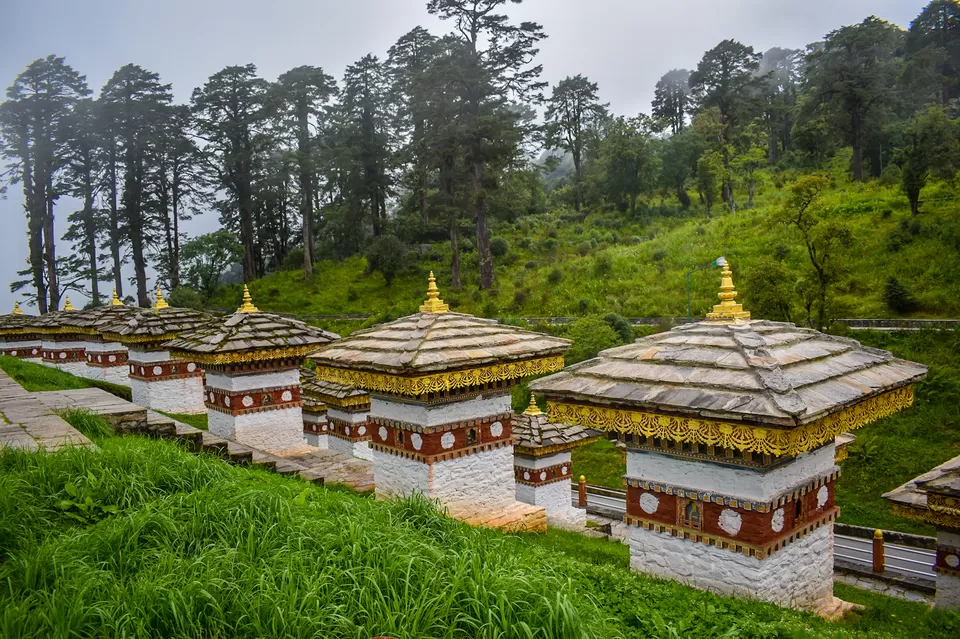
We encountered some beautiful mountain dogs at Dochula Pass. I couldn’t resist myself from clicking these beauties.
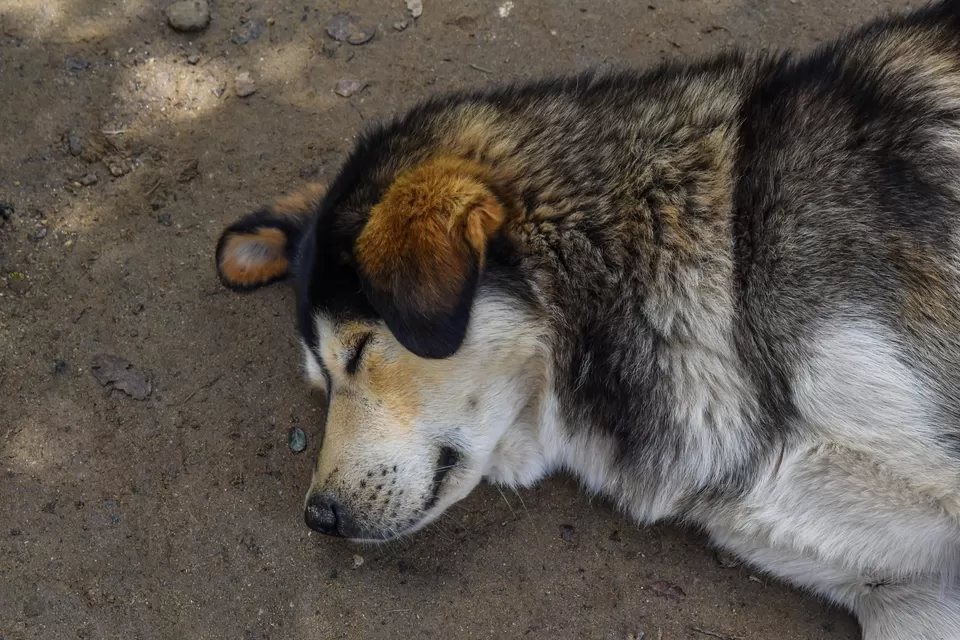
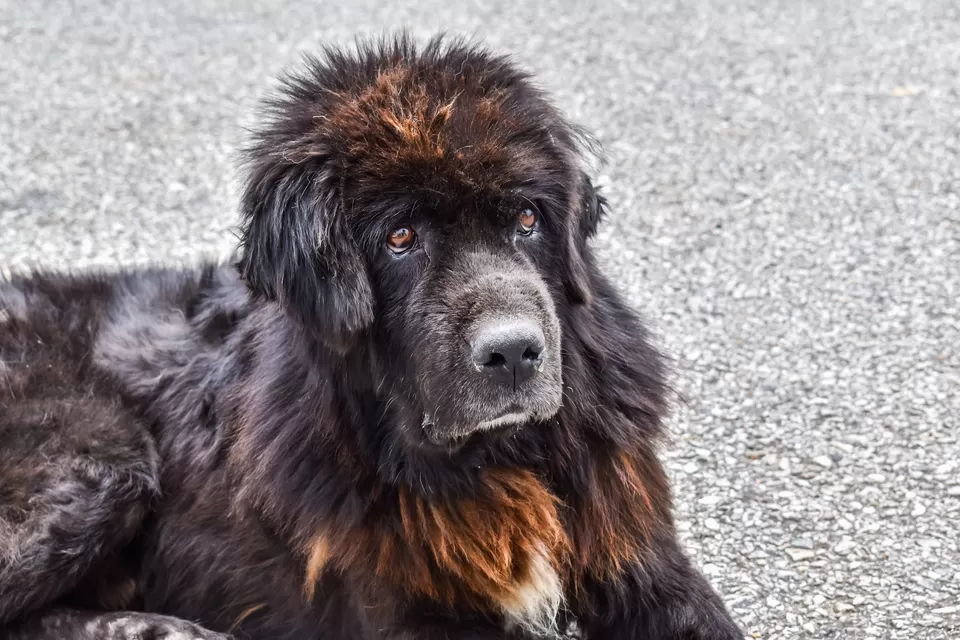
After clicking some photos Dochula Pass we left for our final destination Punakha. We have booked a homestay Namgays homestay at a village Yusakha, Bhutan. Since Punakha Dzong & comes en-route so we decide to visit it as well.
Punakha Dzong
Punakha Dzong is the administrative centre of Punakha district, one of the 20 districts of Bhutan. Punakha was the capital of Bhutan and the seat of government until 1955 when the capital was moved to Thimphu. It is about 72 km away from Thimphu and it takes about 3 hours by car from the capital Thimphu. Unlike Thimphu, it is quite warm in winter and hot in summer. It is located at an elevation of 1,200 metres above sea level and rice is grown as the main crop.
Punakha Dzong has been inextricably linked with momentous occasions in Bhutanese history. The first national assembly was hosted here in 1953. Punakha Dzong is not only the second oldest and second-largest dzong but it also has one of the most majestic structures in the country.
October 13, 2011 marked an unforgettable wedding of the King of Bhutan, Jigme Khesar Namgyel Wangchuck to Jetsun Pema which was held at Punakha Dzong. The Dzong is located between the Pho Chhu (male) and Mo Chhu (female) river in the Punakha–valley. The source of the Mo chu river is in the northern hills of Lighsi and Laya in Bhutan, and in Tibet. The Po Chu River is fed by glaciers in the Lunana region of the Punakha valley. After the confluence of these two rivers, the main river is known as Puna Tsang chu or Sankosh River and flows down through Wangdue Phodrang, crosses the Bhutan–India border at Kalikhola and eventually meets the Brahmaputra River. It is an especially beautiful sight with sunlight reflecting off the water onto its white-washed walls.
In addition to its structural beauty, Punakha Dzong is notable for containing the preserved remains of Zhabdrung Ngawang Namgyal, the unifier of Bhutan as well as a sacred relic known as the Ranjung Karsapani. This relic is a self-created image of Avalokiteswara that miraculously emerged from the vertebrae of Tsangpa Gyarey, the founder of the Drukpa School when he was cremated.
Administrative offices of the dzong, a very large, white-washed stupa and a bodhi tree are located in the first courtyard. Also seen in the same courtyard, on the far left, are a mound of stones and a chapel dedicated to the queen of the nagas. The residential quarters of monks are located in the second courtyard, with the utse intervening in between the first and the second courtyards. There are two historic halls in this courtyard; one of Ugyen Wangchuk, who subsequently became the King and another hall where the King was decorated in 1905 with the Order of the Knight Commander of the Indian Empire by John Claude White. The third courtyard is at the southernmost end of the dzong where the remains of Pema Lingpa and Ngawang Namgyal are preserved. Machey Lakhang (‘machey’ literally means “sacred embalmed body”) in the third courtyard has the well preserved embalmed body of Zhabdrung. This Lakhang was rebuilt in 1995. The casket containing the embalmed body is not opened at all. However, the place is visited by the King and the Je Khenpo mainly to seek blessings before assuming their offices.
After visiting the dzong we had our lunch and then we decided to head towards our stay, Namgay homestay. We rested for the day in our cosy rooms had our dinner. The secluded & tranquil Namgay Zam’s Farmhouse on a small hilltop overlooks the beautiful Hamlet in Punakha. Just a few kilometres away from Po chu Suspension Bridge (the longest in the country), behind the mighty Punakha Dzong, this traditional house offers a mesmerising panorama to behold. The homestay is a traditional farmhouse. Authentic Bhutanese cuisine in their style of dining and the medicinal hot stone baths are the key attractions. It’s an apt place to sit back and enjoy the rural way of living in Bhutan. In the morning I Ajay decided to go for a hike up to the school located in the village. It was quite an ascent and after reaching the top we found that the school area is bordered by barbed wire all around. So we decided to trek down, refreshen ourselves and plan for the day ahead.
Day 6 – 19.08.2019
Punakha Suspension Bridge
The high mountains and deep gorges of Bhutan lend themselves to suspension bridges. Punakha Suspension Bridge, which is always adorned with colourful prayer flags, is the perfect example of this. Linking Punakha Dzong to Shengana, Samdingkha, and Wangkha villages across the Po Chu river, this is one of the longest suspension bridges in Bhutan. Yet, for a roughly 520-foot-long suspension bridge, it’s surprisingly stable. The bridge offers a spectacular view of the river and valley, and the east bank is a good starting point for multi-day treks in the nearby mountains. Traditional Bhutanese bridges make use of cantilevers, beams anchored to one bank and projecting horizontally to reach the other bank. The bridge relies on cables anchored to massive cement blocks on the banks. Being suspended, the bridge does have some inbuilt flexibility that makes it swing in strong winds, but not as much as you may expect. This is due to the stabilizing cables that taper off on both ends of the bridge. The deck is made of solid planks of wood nested in the deck truss.
Finally, we started our journey back home. Enroute we came across a huge waterfall at Chukha. We clicked some photographs and continued our journey. We reached Phuentsholing by around 5:40 PM. We hired an Innova for just Rs. 3500 and reached Siliguri at around 9:30 PM, had our dinner and rested for the day.
Day 7 – 20.08.2019
We took our flights to our respective destinations. The overall cost person came out to be around Rs 23000. I didn’t want to leave this peaceful & mesmerizing place but had no options. The people are so disciplined, follow traffic rules, ensures cleanliness & hygiene, follow their traditional beliefs and whatnot. A pastoral delight with cascading red rice fields, beautiful valleys, humbling mountain ranges and something to offer for every traveler you can’t forget Bhutan. So come and experience the charm of one of the most inexplicable countries, the last Shangri La, the land of the thunder dragon and be mystified as you explore travel world’s best-kept secret, Bhutan.
Frequent searches leading to this page:-
Bhutan vacation, Bhutan vacation packages, Bhutan trip plan, Bhutan tourism cost, best Bhutan packages, holiday in Bhutan tours & travels

